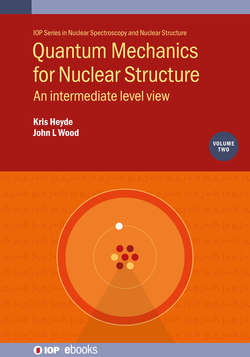Читать книгу Quantum Mechanics for Nuclear Structure, Volume 2 - Professor Kris Heyde - Страница 17
На сайте Литреса книга снята с продажи.
1.9 A spherical harmonic basis for SO(3)
ОглавлениеThe use of spinor functions as a basis for SU(2) and the relations for Jˆ0, Jˆ± given in equations (1.172)–(1.174) lead to the consideration of a functional representation of the ∣lm〉 for (ℏ≡1)
Lˆ0=Lˆz=xˆpˆy−yˆpˆx↔−ix∂∂y+iy∂∂x;(1.177)
Lˆ+=Lˆx+iLˆy=yˆpˆz−zˆpˆy+izˆpˆx−ixˆpˆz,(1.178)
∴Lˆ+↔−iy∂∂z+iz∂∂y+z∂∂x−x∂∂z;(1.179)
Lˆ−↔−iy∂∂z+iz∂∂y−z∂∂x+x∂∂z;(1.180)
where the postion representation has been used. Evidently, Lˆ0, Lˆ± in the form given by equations (1.177), (1.179) and (1.180) leave the degree of a polynomial in x, y and z unchanged. Therefore, we consider the space of homogeneous polynomials in x, y and z, i.e.
f(x,y,z)=(ax+by+cz)l,(1.181)
where a, b, and c are complex numbers.
We start with the homogeneous polynomials ϕlm=−l(r⃗), r⃗≔(x,y,z), that satisfy the so-called ‘lowest weight’ conditions:
Lˆ0ϕl,−l(r⃗)=−lϕl,−l(r⃗)(1.182)
and
Lˆ−ϕl,−l(r⃗)=0.(1.183)
Then, consider
Lˆ0(ax+by+cz)l=−ix∂∂y+iy∂∂x(ax+by+cz)l=−ixl(ax+by+cz)l−1b+iyl(ax+by+cz)l−1a=l(ax+by+cz)l−1(−ibx+iay),(1.184)
and the right-hand side fulfils equation (1.182), i.e.
Lˆ0(ax+by+cz)l=−l(ax+by+cz)l,(1.185)
provided a=1,b=−i,c=0. Thus,
ϕl,−l(r⃗)=(x−iy)l.(1.186)
Evidently,
Lˆ−ϕl,−l(r⃗)=−iy∂∂z+iz∂∂y−z∂∂x+x∂∂z(x−iy)l=izl(−i)(x−iy)l−1−zl(x−iy)l−1=0.(1.187)
We can construct the ϕlm(r⃗) using (ℏ≡1)
Lˆ+ϕlm(r⃗)=(l−m)(l+m+1)ϕl,m+1(r⃗).(1.188)
For l = 1: from
ϕ1,−1(r⃗)=x−iy,(1.189)
Lˆ+ϕ1,−1(r⃗)=−iy∂∂z+iz∂∂y+z∂∂x−x∂∂z(x−iy)=iz(−i)+z=2z≔2ϕ1,0(r⃗);(1.190)
∴ϕ1,0(r⃗)=2z.(1.191)
Then,
Lˆ+ϕ1,0(r⃗)=2−iy∂∂z+iz∂∂y+z∂∂x−x∂∂zz=2(−iy−x)=−2(x+iy)≔2ϕ1,1(r⃗);(1.192)
∴ϕ1,1(r⃗)=−(x+iy).(1.193)
For l = 2: from
ϕ2,−2(r⃗)=(x−iy)2,(1.194)
Lˆ+ϕ2,−2(r⃗)=−iy∂∂z+iz∂∂y+z∂∂x−x∂∂z(x−iy)2=iz2(x−iy)(−i)+z2(x−iy)=4z(x−iy)≔2ϕ2,−1(r⃗);(1.195)
∴ϕ2,−1(r⃗)=2z(x−iy).(1.196)
Then,
Lˆ+ϕ2,−1(r⃗)=−iy∂∂z+iz∂∂y+z∂∂x−x∂∂z2z(x−iy)=−iy2(x−iy)+iz2z(−i)+z2z−x2(x−iy)=−2(x−iy)(x+iy)+4z2=−2(x2+y2)+4z2≔6ϕ2,0(r⃗);(1.197)
∴ϕ2,0(r⃗)=23(−x2−y2+2z2).(1.198)
Similarly,
ϕ2,1(r⃗)=−2z(x+iy),(1.199)
ϕ2,2(r⃗)=(x+iy)2.(1.200)
The functions ϕlm(r⃗) are proportional to the spherical harmonics, Ylm(θ,ϕ) (see table 1.1). This follows from the relationship between Cartesian coordinates and spherical polar coordinates:
x=rsinθcosϕ,y=rsinθsinϕ,z=rcosθ,(1.201)
whence
ϕ1,±1=∓(x±iy)=∓rsinθe±iϕ=r8π3Y1,±1(θ,ϕ).(1.202)
Similarly,
ϕ1,0(r⃗)=2rcosθ=r8π3Y1,0(θ,ϕ).(1.203)
ϕ2,±2(r⃗)=r2sin2θe±2iϕ=r232π15Y2,±2(θ,ϕ).(1.204)
ϕ2,±1(r⃗)=∓2r2cosθsinθe±iϕ=r232π15Y2,±1(θ,ϕ).(1.205)
ϕ2,0(r⃗)=r223(3cos2θ−1)=r232π15Y2,0(θ,ϕ).(1.206)
In general,
ϕl,±l(r⃗)=(∓1)l(rsinθcosϕ±irsinθsinϕ)l,(1.207)
i.e.
ϕl,±l(r⃗)=(∓1)lrlsinlθe±ilϕ.(1.208)
The spherical harmonics Yl,m=±l(θ,ϕ) are:
Yl,±l(θ,ϕ)=(2l+1)!!4π(2l)!!e±ilϕsinlθ,(1.209)
where (2l)!!≔(2l)(2l−2)(2l−4)…2or1 and
∫02πdϕ∫0πsinθdθ∣Yl,±l(θ,ϕ)∣2=1.(1.210)
Thus,
ϕl,±l(r⃗)=rl4π(2l)!!(2l+1)!!Yl,±l(θ,ϕ).(1.211)
It then follows from
ϕlm(r⃗)=(l−m)!(2l)!(l+m)!(Lˆ+)l+m(x−iy)l,(1.212)
which is obtained by repeated application of equations (1.186)–(1.188), that a general spherical harmonic is given by
Ylm(θ,ϕ)=12ll!(2l+1)(l−m)!4π(l+m)!1rl(Lˆ+)l+m(x−iy)l.(1.213)
This leads to the general expression for spherical harmonics:
Ylm(θ,ϕ)=12ll!(2l+1)(l−m)!4π(l+m)!eimϕ(−sinθ)mdd(cosθ)l+m(cos2θ−1)l.(1.214)
The spherical harmonics are related to the Legendre polynomials, Pl by:
Pl(cosθ)=4π2l+1Yl,m=0(θ,ϕ).(1.215)
Table 1.1. The spherical harmonics, Ylm(θ,ϕ), m=l,l−1,l−2,…,1,0,−1,…,−l+1,−l, for l=0,1,2, and 3. They are normalized for 0⩽ϕ⩽2π, 0⩽θ⩽π.
| l | m | Ylm(θ,ϕ) |
|---|---|---|
| 0 | 0 | 14π |
| 1 | 0 | 34πcosθ |
| 1 | ±1 | ∓38πe±iϕsinθ |
| 2 | 0 | 516π(3cos2θ−1) |
| 2 | ± 1 | ∓158πe±iϕcosθsinθ |
| 2 | ±2 | 1532πe±2iϕsin2θ |
| 3 | 0 | 6316π53cos3θ−cosθ |
| 3 | ±1 | ∓2164πe±iϕ(5cos2θ−1)sinθ |
| 3 | ±2 | 10532πe±2iϕsin2θcosθ |
| 3 | ±3 | ∓3564πe±3iϕsin3θ |
